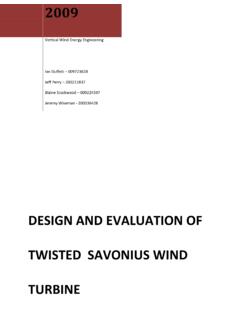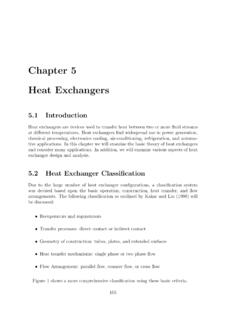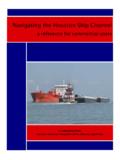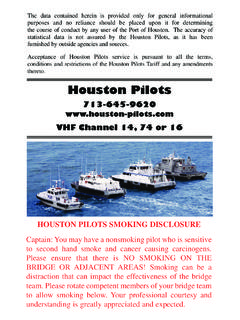Transcription of SHIP TERMS AND DEFINITIONS
1 E6002 ship TERMS & DEFINITIONS p. 1 ship TERMS AND DEFINITIONS A Abaft ----Aft of; farther aft than. Access Holes---- Holes cut in ship 's structure to permit entering or leaving various compartments. Accommodation Ladder---- A portable set of steps on a ship 's side for the accommodation of people boarding from small boats or from a pier. Aft ----Toward, at, or near stern. After----- Nearer stern. Aftermost---- Nearest the stern. After Body---- Hull form aft of the midship section. After Peak---- The compartment in the narrow part of the stern, aft of the last water-tight bulkhead. After Peak Watertight bulkhead farthest aft. After Perpendicular ( ) ---- A vertical line usually at the after end of the rudder post. If there is no rudder post, it usually is taken at the center of the rudder stock. Air Hammer---- Hammer driven by compressed air for riveting, or chipping.
2 Sometimes called an air gun or "gun." Air Port ----A circular opening or window through the ship 's, or deck house, for light or ventilation. Amidships ----At or near the midship section of the ship . Anchor---- A heavy hook-shaped device for holding a ship at rest in water. The anchor grips the ocean bottom and is fastened to the ship by a chain. Angle Clip---- A short piece of angle bar. Angle Collar ----A ring made of angle bar. Anneal ----To soften metal by heating and allowing it to cool slowly. Anode ----Zink or aluminum or some such alloy that is fixed to the hull of a vessel. They are 'eaten' up by electrical currents moving from the vessel to the water. The anode is sacrificed to protect the metal hull of the vessel - without the anode, the hull plating would be disolved by electrolysis. This anode has been partly sacrificed by electrolysis on this vessel.
3 It is still in good enough shape to keep on the vessel and is doing its intended job very well. This is a new anode on a vessel , it has been welded in place. The shipyard did a good job of not painting the anode. Aperture ----A recess in which the propeller is located. E6002 ship TERMS & DEFINITIONS p. 2 Assemble ----To fit together small parts, in making a large section, or part . Athwartship ----Across the ship at right angles to the centerline. Auxiliaries ----Machinery supplementary to main propulsive units. Awning Deck ----Shade deck above another deck. B Ballast ----Any weight or weights (usually sea water, but could be concrete, scrap steel, etc.) used to keep the ship from becoming "top heavy" or to change her trim. Some of the largest cannons in the navy were on hospital ships - they were in the bilge for ballast. Ballast Tank ----Watertight compartment to hold ballast.
4 Barge ----A water tight vessel that floats in water. Picture of 2 loaded inland rivers tank barges, carrying liquid cargo. Barges also come in open and closed hopper styles, and with flat decks. These 2 tank barges are loaded with petrochemicals in the Houston, Texas, USA ship channel. The boat that is pushing them is called a tow boat, because it pushes a 'tow of barges'. Covered hopper barge loaded with steel. Barnacle ----Small marine growth which attaches itself to a vessel's hull in large numbers, often greatly retarding her speed. Base Line ----A straight horizontal line at or near the bottom of the moulded surface from which vertical heights are measured. Usually, the base line is the very lowest part of the moulded surface. In Fig. 2 is shown an exception. Battens ----Long strips of wood used in the mold loft for fairing lines; also, wooden protective strips in cargo holds; see hatch battens.
5 Beam ----An athwartship member supporting a portion of a deck. Also, the width of the ship . Beam Knee ----(See Bracket) Below ----Below a deck or decks (corresponding to "downstairs"). Bending Rolls ----Large machine used to give curvature to plates. Also see 'press brake'. Bending Slab---- Heavy cast iron perforated slabs arranged to form a large floor on which frames, etc., are bent. Berth ----A place for a ship ; a place to sleep; a bunk; also, a specified small section of the hull structure. E6002 ship TERMS & DEFINITIONS p. 3 Between Decks ----The space between any two decks. Bevel ----The angle between the flanges of a frame or other member. (When greater than a right angle, open bevel; when less, closed.) Also, to chamfer. Bilge ----Curved section between the bottom and the side of a ship ; the recess into which all water drains.
6 Bilge Blocks ----Supporting blocks used under bilge for support during construction or drydocking. Bilge blocks supporting a vessel on a drydock. More bilge blocks. Bilge ----A fore and aft member fitted to the outside of the shell plating along the bilge, to prevent excessive rolling of the ship . Bilge Pump ----Pump for removing bilge water. Bilge Strake ----Course of plates at the bilge. Bilge Water ----Water in ship due to leaks, sweat, etc. Bilge Well ---- A sump to which bilge water drains. Binnacle ----A case, box, or stand containing a ship 's compass, adjusting magnets, and a lamp for use at night. Bitt ----A vertical post used in making fast lines; a bollard. Double post bitt. A single post item similar to this would be a bollard. It is easier to secure and remove a rope on a double post bitt. Bitumastic ----An elastic cement used in place of paint to protect steel.
7 Boat Deck ----A deck on which lifeboats are kept. Body Plan ----A drawing which shows frame lines in elevation. The body plan is made in two parts. The right-hand part is a view looking directly aft at the for'd port side of moulded surface, while the. left-hand part is a view looking directly forward at the after half of the port side. This arrangement prevents the frame lines at the after end from obliterating or fouling the frame lines at the forward end. This view shows buttocks and waterlines straight, while the frame lines appear in their true shape. Boiler ----Container in which water is heated to form steam. Boiler Chocks ----Stay braces which prevent fore and aft movement of boilers. Boiler Foundation ----A support for a boiler. Bollard ----A single tie post (see bitt). Booby Hatch ----A watertight covering over a deck opening, which is used for a stairway or ladder.
8 Boom ----A long, round, heavy spar, pivoted at one end, usually used for handling cargo, etc. E6002 ship TERMS & DEFINITIONS p. 4 Here is a davit, or a cargo hose boom. This one design of several different types of devices designed to assist in lifting heavy items. The King Post or Sampson Post or Stanchion is the vertical pipe on the right side of the picture. The boom (spar) extends to the left, and is supported by a boom rest near the tip, and the boom socket (step) at the base of the king post. Boom Rest ----A support for a boom when the boom is not in use. Boom Step ----A socket for end of boom. Bosom Piece ----A short piece of angle riveted over a butt joint of two angles, a butt strap for angle bars; a splice piece. Boss ----The curved swelling portion of the ship 's hull around the propeller shaft. Propeller on a ferry. Most US ferry's have identical propellers on both ends.
9 This way they do not have to back up to get into the slip, making it much easier for the vehicles to drive on and off. The boss and the oxter plate is here somewhere. Propeller on a river towboat. This one has 4 blades and is designed for power rather than speed. 4 blade propellers have less vibration than 2 or 3 blade propellers, benefiting the crew. Boss Frame ----A hull frame which is bent for clearing propeller shaft tube boss Boss Plate ----A shell plate covering the curved portion of hull where the propeller shaft passes outboard. Bow ----The forward end of a vessel. (Usually the pointed end.) Here is the bow of a tank barge on drydock. Bowsprit --A spar projecting forward from the bow of a vessel used to attach sails and stays. Bracket ----A triangular plate used to connect rigidly two or more parts, such as a deck beam to a frame, a frame to a margin plate, etc.
10 Braze ----To heat and join by means of hard solder (spelter). This may be brass, bronze, or other alloys. Breakwater ----A braced guard plate which prevents solid water from sweeping the decks. E6002 ship TERMS & DEFINITIONS p. 5 Breast Cap ----Small plate on top of bulwark, at stem of vessel to stiffen bulwark. Breast Hook ----A triangular-shaped plate extending horizontally across the bow behind the stem, stiffening the stringers and stem. Bridge, Navigating ----A deck from which the ship is navigated. Bridge Deck ----A deck of the superstructure amidships. Brow ----A watershed over an airport; a small inclined runway to allow passage of trucks over hatch coaming, or through bulkhead door, etc.; sometimes portable. Buck frame ----In a double skin tank barge, these frames act as spacers in the void tanks. A 4'6" wide void might have 2 vertical 8" channel iron with 3" x 3" x 5/16" angle iron between.










